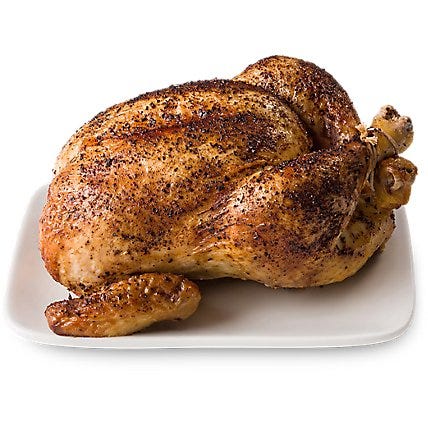I am a chicken mortician, preparing whole body chickens for their final resting place on your kitchen table. I take the raw bodies and embalm them with seasoning—some traditional, some rosemary and garlic—then pose them, legs crossed, on a tray of ascending spikes. From there, I wheel them, two dozen at a time to the oven, and roast them to an almost-but-not-quite burnt brown. After the oven, they are put in the plastic bag caskets for your viewing pleasure and onto the shelf, where you can spend minutes of your precious life deciding which one is best.
The birds come twelve to a box, heavy double-walled cardboard, swimming in a liquid inside a plastic bag as thick as a raincoat. I don’t know how the tiny Latina ladies get them out and into the sink—a box weighs 60 pounds, and the liquid weight shifts as you lift it. I’m in the 240s these days and it’s not that easy.
Usually, they spill out in the stainless steel prep sink, where I put them on their backs and coat their bellies with two different kinds of seasoning. This seasoning comes in bags from corporate headquarters, so that every roasted chicken you buy in any store in the country will taste the same. This taste is what hooks the customer, so they don’t want chicken from anywhere else, and when the customers slow down on buying it and the chicken inventory increases, the store blasts their apps and emails that it’s a $5 sale, and everyone busts ass to relapse in-store. Of course, once they’re in there buying a whole chicken, they fill up the rest of their cart with potato salad, Hawaiian rolls, and ice cream cakes.
But yesterday, I opened a box and the chickens were mangled up together like the front row of a Who concert. One frozen lump of jiu-jitsu wrestling birds that I had to separate without cracking off wings or drumsticks. I sprayed them down with warm water, hoping the ice between them would melt. Carefully, they were pried apart, but instead of looking ready for their makeup, they looked like one of those American Sign Language cards that deaf people passed out in the ‘70s.
I hadn’t thought about why the chickens always come out properly, but just pictured another new guy like me, filling the chicken bags as fast as he could on his first day at the factory farm slaughterhouse assembly line, before someone stops him and says, “Holy shit dude, you can’t do it that way, you’ll make a moshpit out of them.” And then that moment where he thinks, do I need to redo all these boxes? And the kid who was supposed to be training him but was out behind the dumpsters hitting a THC vape just says, “fuck it,” and they act like nothing ever happened. In some long, extended sense, those are my coworkers, too.
You have to cross a chicken’s legs behind this spike to keep the legs in place—otherwise, they will stick to the bottom of the oven. But these chickens’ wings and legs were spread in full semaphore positions, some with caved-in breasts, or flat on one side. And they were frozen in place—although I had thawed the ice between them, the bodies themselves were still unforgiving.
I massaged them, but my hands lost all heat. I tried to press them back into place, into their proper postures, but still, they acted out Madonna’s “Vogue” video. I pressed, pushed, massaged them.
“Are you okay?” one of my coworkers asked.
“These birds all look surprised,” I said, holding one up with splayed-out wings.
She stared at me, then walked away.
I got those birds seasoned, on their spikes, and in the oven. I took them out and was able to use the bags to hold them in a proper position somewhat.
No one said anything.




“These birds all look surprised,” I said, holding one up with splayed-out wings.
She stared at me, then walked away.
_____________________________________
I would have laughed. Then again, I'm usually the one getting blank stares from my coworkers. (Though I've never had a sushi chef point a knife at me.)
You've just inadvertently linked up the cosmic chain of interconnectedness. We are all connected (by chicken).